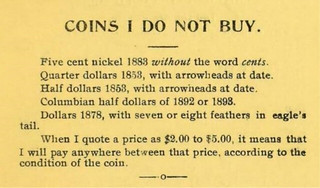
PREV ARTICLE
NEXT ARTICLE
FULL ISSUE
COINS WE DON’T BUYThe January 2017 issue of The E-Gobrecht, the electronic newsletter of the Liberty Seated Collectors Club has an article by Len Augsburger about "Coins We Don't
Buy" lists. With permission, here's it is. -Editor
Dealers need to find coins to sell, and, in the pre- Internet era, a typical way to do this was to issue a “prices paid for” list. These pamphlets provided basic information for the public to sort good coins from bad, and included instructions for shipping the better pieces to the acquisitive dealer. Prices paid for lists might be distributed gratis to more promising leads, but were also sold through a variety of publications. Some speculate that dealers made more from selling lists than from buying coins and there is likely some truth to this. I recall an overly excited childhood friend who paid $2 for such a list (about $10 in present terms) and was sure that instant riches could be picked out of pocket change after the secrets of the coin dealer were revealed. Such are the $2 lessons we learned in our youth. One occasional feature of these lists was the “Coins We Don’t Buy” section. Yes, there is swill that even coin dealers refuse. I recall the first time I visited Stack’s in New York City. I was sure that only the sexiest, most glamorous coin business would be transacted in such a longstanding, esteemed establishment of rare coindom. Alas, while browsing the stock, I was treated to the Stack’s side of a barrage of phone calls from general public. “No, it’s not copper – put a magnet on it” (response to a caller who was certain their corroded 1943 Lincoln cent was copper and not steel). “It’s only worth face value – we do not buy them.” “No, a 1913 Buffalo nickel is not worth a million dollars, I’m sorry.” And on and on. Later I learned that when working at Stack’s you *start* at the coin counter and eventually graduate to the back rooms, where many of the best coins go to private clients before any- one one else hears about them. In any case, coin dealers spend a good amount of time explaining why they have no interest in various items. The “Coins We Don’t Buy” list played this role in former times. Thomas Elder, a New York dealer, mentioned two such coins in his c. 1920 prices paid for list – the 1853 Arrows & Rays quarter and half dollar. Both of these were struck in massive quantities, and must have been readily available in circulation well into the 20th century. These two coins regained popularity only much later, with the promotion of “type” collecting as a way to approach the U.S. series. William P. Brown, also of New York, issued a list in 1899 that similarly refused the Arrows & Rays coinage, and added the 1861 half dollar to the “don’t buy” list. This is another common date, and, while interest in Civil War-dated coinage has created some demand, it remains easy to locate. The Connecticut Coin Company, in a circa 1930 list, also eschewed the 1853 Arrows & Rays quarters and half dollars, as did Charles Windau of Red Wing, Minnesota in a 1911 list. Illustrated below is Thomas Elder’s “don’t buy” list from his circa 1920 prices paid for list.  To more information on the Liberty Seated Collectors Club, see:  Wayne Homren, Editor The Numismatic Bibliomania Society is a non-profit organization promoting numismatic literature. See our web site at coinbooks.org. To submit items for publication in The E-Sylum, write to the Editor at this address: whomren@gmail.com To subscribe go to: https://my.binhost.com/lists/listinfo/esylum All Rights Reserved. NBS Home Page Contact the NBS webmaster 
|